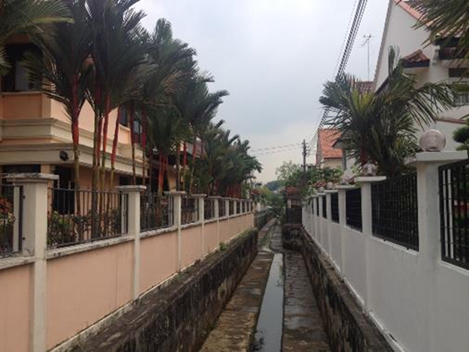First-of-its kind stormwater retention pond integrated with Bidadari Park
.jpg?h=426&w=720&hash=93942854B2B72038A53202177D64FB49)
Overview of Alkaff Lake
Alkaff Lake, situated in the new Bidadari estate, is a first-of-its-kind multi-functional drainage infrastructure for stormwater management, enhancing flood protection for Bidadari estate and the surrounding areas. In dry weather, it looks like a regular lake and forms part of the recreational and aesthetic community space for the public. During heavy rainfall, it plays an important role in controlling stormwater runoff.
Innovative solution to mitigate flood risk
2 To cater for the development of Bidadari estate, there was a need to address an increase in stormwater runoff. Alkaff Lake was conceived in close collaboration with agencies such as Housing & Development Board (HDB) and National Parks Board (NParks) as an innovative solution that balances the need for drainage improvements, while also enhancing the overall liveability of the area by incorporating blue and green spaces. The 1.8-hectare lake is designed to hold up to 40,000 cubic metres of water, the equivalent of 16 Olympic-sized swimming pools1.
3 During a heavy storm, runoff from half of Bidadari estate (43.5 hectares) will be diverted into Alkaff Lake, which is the lowest point in the area. This allows for large amounts of stormwater to enter the lake, which has outlet points to control the release of stormwater. By capturing and retaining the stormwater from nearby areas, the lake regulates and slows down the amount of runoff (refer to Annex A) that flows into the downstream drainage system2, which cannot be widened further due to space constraints. This helps to mitigate flood risk in the areas downstream of the Bidadari estate.

The Happy Avenue outlet drain, located downstream of the Bidadari estate, is flanked by houses on both sides.
4 In land-scarce Singapore, it is not always practical to build bigger drains. To mitigate flood risks, PUB adopts a holistic approach3 towards stormwater management and has made significant strides in improving our drainage infrastructure through long-term planning and investment. Alkaff Lake’s multi-functional design drew inspiration from Kallang River @ Bishan-Ang Mo Kio Park, where a concrete canal was transformed into a scenic waterway. This was based on a flood plain concept for flood management, where the flow of water is confined to a narrow stream in dry weather; during heavy rainfall, the adjacent park area doubles as a conveyance channel for stormwater.
Ensuring public safety
5 The water level in Alkaff Lake is typically maintained at between 1 and 1.5 metres. When there is heavy rain, the water level could rise up to 4 metres. Public should not be alarmed as the lake is functioning as intended to capture and hold the stormwater. To ensure public safety, PUB has implemented a robust warning system around the lake, which is tied to automatic sensors that monitor the water level. As the water level rises, beacon lights and audio broadcasts in four languages will be activated to inform the public to move away from the lake. There are also red safety markers and signages to educate visitors on the areas they should avoid (refer to Annex B).
A water level sensor in the lake (left) and the public broadcast system (right)
Keeping water clean and providing community spaces
6 Alkaff Lake incorporates PUB’s Active, Beautiful, Clean Waters (ABC Waters) design features such as terraced wetlands and swales4, which are integrated with our drainage infrastructure where feasible to create more liveable spaces that bring the public closer to water. Visitors can take in the panoramic view of the cascades and lake from the nest shelter or the large viewing deck which extends over the water.
7 To ensure good water quality in the lake, the terraced wetlands and swales help to cleanse and filter pollutants from stormwater runoff. Gross Pollutant Traps (GPT) are installed to trap litter and silt that are accumulated in the runoff, while aerators within the lake improve water circulation and increase the amount of dissolved oxygen in the water (refer to Annex C for key features).
-END-
About ABC Waters Programme
The Active, Beautiful, Clean Waters (ABC Waters) Programme is a long-term strategic initiative by PUB to improve the quality of water and life by harnessing the full potential of our waterbodies. By integrating the drains, canals and reservoirs with the surrounding environment in a holistic way, the ABC Waters Programme aims to create beautiful and clean streams, rivers, and lakes with postcard-pretty community spaces for all to enjoy.
The programme was launched in 2006 and aims to provide new community and recreational spaces, improve the aesthetics of the urban environment, and improve water quality though the use of natural cleansing features (also known as ABC Waters design features). By transforming Singapore’s canals, rivers and reservoirs into beautiful recreational spaces where people can be close to water, the initiative serves to increase the public’s awareness and appreciation of water-related issues while encouraging the community to become stewards of the waterways and waterbodies.
To date, PUB has completed 55 ABC Waters projects around the island. ABC Waters projects are rolled out progressively in conjunction with drainage improvement works or in tandem with development plans by other agencies or stakeholders.
Footnotes:
[1] During dry weather, Alkaff Lake holds about 10,000 cubic metres of water.
[2] Stormwater from Alkaff Lake flows to the Happy Avenue outlet drain, which discharges to Pelton Canal. The canal is one of the major waterways that leads to the Kallang River and subsequently to Marina Reservoir.
[3] PUB’s holistic ‘Source-Pathway-Receptor' approach looks at catchment-wide solutions that intervene from the upstream to downstream of drainage infrastructure. This approach introduces flexibility and adaptability to Singapore’s entire drainage system, addressing not just the drains and canals through which stormwater travels (i.e. “Pathway”), but also in areas generating stormwater runoff (i.e. “Source”) and areas where floods may occur (i.e. “Receptor”). For more information, refer to: https://www.pub.gov.sg/Public/WaterLoop/Drainage
[4] A swale is a natural conveyance system that conveys stormwater at a slower speed to allow the settlement of sediments before it enters a waterbody.